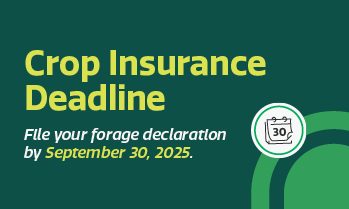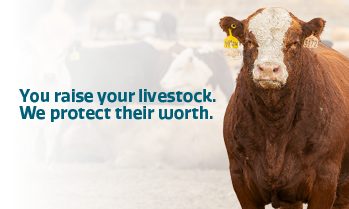Weather-Based Programs Support Livestock Producers
Article written by SCIC
(Variation of this article is also available in 2024 Yield Saskatchewan publication presented by The Western Producer)
Saskatchewan forage and livestock producers remain resilient, as drought challenges their operations. In 2021 to 2023, sourcing and transporting feed in tight supply highlighted the importance of available and timely cashflow for livestock producers.
SCIC's Weather-Based Programs are designed to protect producers against weather-related risks. Programs include the Forage Rainfall Insurance Program, Mixed Forage Rainfall Insurance Program, Intercrop Rainfall Insurance Program, Corn Rainfall Insurance Program and Corn Heat Unit Insurance Program.
In 2023, the Forage Rainfall Insurance Program paid a record-breaking $60.4 million total indemnities to participating producers across 17 forage risk zones. Over 90 per cent of the 3.35 million insured acres enrolled received a payment. In 2023, the average Forage Rainfall Insurance Program premium cost per producer was $3.35 per acre. The average claim payment resulted in $19.44 per acre.
These results are a testament to how closely SCIC works with Saskatchewan livestock industry groups to ensure business risk management programs remain relevant to producers’ needs. SCIC continues to lead collaboration through its Forage Working Group to make recommendations for enhancements to SCIC’s forage programs. This working group includes members from the Saskatchewan Cattlemen’s Association, Saskatchewan Stock Growers Association, Saskatchewan Forage Council, Saskatchewan Association of Rural Municipalities and The Agricultural Producers Association of Saskatchewan.
In 2022, a notable enhancement was the addition of the excess heat adjustment to these weather-based programs. This enhancement, which reduces rainfall accumulations in situations of high heat to account for the loss of moisture available to the plant, results in a higher likelihood of receiving a payment. For the Forage Rainfall Insurance Program and the Corn Rainfall Insurance Program claim calculations, the monthly accumulated precipitation was reduced by 1.0 mm for any day in the month a station reaches +31.0°C. In 2023, the excess heat adjustment accounted for $5.8 million of total indemnity paid to producers.
Saskatchewan producers strive for optimal production through good growing conditions. As with other forms of insurance, purchasing insurance is not about making money – it is about proactive planning to have protection when you need it. SCIC recognizes no growing season is the same. Each can bring its own set of production challenges. A good indicator of an effective program is not how it responds to the good growing season but examining returns to producers during challenging ones. Over the last five years, Saskatchewan experienced significant dry conditions and drought pressures. The Forage Rainfall Insurance Program responded accordingly. On average across the province, the Program paid $4.40 in eligible claims for every $1.00 of producer paid premium. Claims are based on precipitation at the weather stations. Individual’s precipitation values may vary, relative to proximity to the stations.
New for 2024
Introduced for the 2024 Crop Insurance Program, SCIC’s weather-based programs now provide options to insure intercrops, along with crops for grazing and livestock feed.
Mixed Forage Rainfall Insurance Program: protects any forage feed crop not previously covered under weather-based programs, including greenfeed and silage, if seasonal precipitation is below average.
All weather-based programs are enhanced by increased weather station density province-wide. Most land is located within 30 kilometres of at least one weather station. One weather station can be selected for each insured and location. This allows producers to insure each of their land locations with relevant coverage.
Forage and Corn Rainfall Insurance Program Details
The Forage Rainfall Insurance Program insures all types of grazing and tame hay acres, protecting pasture and hay land. Similarly, the Corn Rainfall Insurance Program insures against a lack of moisture over the growing season for seeded corn, whether it be for grain, silage or grazing.
Actual precipitation at a weather station is compared to the long-term average to determine the “monthly per cent of normal” precipitation. This is multiplied by the monthly weighting and calculated each month of the growing season. A producer is in a claim position when the precipitation at their selected weather station is below 80 per cent of normal.
Producers can select several different options to customize their rainfall coverage:
- Weather stations – Data for these programs are collected from a network of weather stations across the province. Producers can select any station within 100 km of their insured land.
- Weighting option – Choosing different monthly weighting options for each insured land location allows producers to determine when rainfall is the most important for their land.
- Precipitation cap – To help ensure a large weather event in one month does not impact indemnities, producers select a cap of either 125 or 150 per cent of normal precipitation for each insured land location. Any precipitation above this selected cap in any month is not included in the claim calculation.
- Coverage level – Select from three levels of coverage (low, medium and high), offering flexible risk management and related premium cost options.
- For 2024: Coverage levels now better reflect the productive capacity of the insured acres. An increased transportation allowance recognizes the costs associated with replacing lost feed.
The Forage Rainfall Insurance Program coverage levels are set yearly based on seasonal forage prices. Producers can select from a range of coverage dependent on the soil zone and the type of insured forage. The Corn Rainfall Insurance Program coverage is based upon dollar-per-acre values and reviewed periodically based on market conditions.
Corn Heat Unit Insurance Program Details
This Program provides risk management for corn producers who experience low temperatures during the growing season or early frost. The Corn Heat Unit Insurance Program starts accumulating corn heat units on May 15 of each year and stops when an individual station reaches -1.0°C for any length of time. Program payments are based on the current year’s accumulated corn heat units compared to long-term normal (which is based on historical weather data from each weather station). If the program year has less than 95 per cent of normal corn heat units, the producer is in a claim position. For each per cent below 95, the producer receives four per cent of the insured coverage.
Under this program, producers can select the coverage options of $150, $175, $250 and $350 per acre. If a producer participates in both the Corn Heat Unit Insurance Program and the Corn Rainfall Insurance Program, coverage is automatically set at $175 for each program.
2024 Forage and Livestock Program Options
SCIC offers various business risk management programs to meet the needs of forage and livestock producers. SCIC encourages producers to review their coverage and available options. Contact SCIC to build a risk management plan to meet the needs of your operation!








